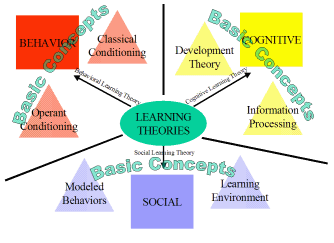
Various theories of learning have been
suggested, and these theories differ for a variety of reasons. A theory is a
combination of different factors or variables woven together in an effort to
explain whatever the theory is about. Theories based on scientific evidence are
considered more valid than theories based on opinion. Learning is defined as a
process that brings together personal and environmental experiences and
influences for acquiring, enriching or modifying one’s knowledge, skills,
values, attitudes, behavior and world views. The relationship between
theories and practice is complicated by there being more than one type of learning.
In the media segment Dr. Orey discussed
how in the past educational institutions prepared their learners to acquire a
set of skills that they would be utilized for a single life long career. 21st
century learner require a different set of skills to be prepared for constantly
evolving world. Nearly every educational setting involves several
types of learning, each with its unique importance to the functioning of the
classroom.
From learning theories like Behaviorism,
Cognitivism, Constructivism, and Social Learning, it might be possible to
extrapolate future models of learning taking into account the interconnections
of the theories and the increasingly networked and connected world we live in
(Laureate Education, n.d.). Connectivism and Social Learning are
prevalent in today’s classrooms. Social learning suggests that students
understand content in a more meaningful ways through active engagement in
conversations and building artifacts with peers (Laureate Education, n.d.). This
theory states that students can learn from one another by actively participating
in a social group. Cooperative learning and multimedia experiences are two
instructional strategies that support social learning. Utilizing these
strategies will enhance student learning and create lifelong learners. Cooperative
learning occurs when groups of students interact with each other to enhance learning
(Pitler, Hubbell, & Kuhn, 2012). Technology can be used to support
learning in this type of collaboration. When students interact with each other
in social situations and learn the curriculum and are very likely to retain
this information. They are able to interact with information on a deep
level, thus committing it to their long-term memories. Technology is
changing how we learn and providing new ways for social learning to
occur.
Reference:
Laureate
Education (Producer). (n.d.). Social learning theories [Video
file]. Retrieved from https://class.waldenu.edu
Orey,
M. (Ed.). (2001). Emerging perspectives on learning, teaching, and
technology. Retrieved from http://epltt.coe.uga.edu/index.php?title=Main_Page
Excellent visual on learning theories. I agree with what you mention about living in a constantly evolving world. As educators, we must stay abreast of new methods, strategies, technological changes in order to prepare our students with 21st century skills. Cooperative and social learning are practices that will help our students be prepared for problem-solving in their future employment.
ReplyDeleteAmalia
What are some digital activities you use to implement cooperative learning strategies? I think using blogs and digital stories are great ways to approach social learning in the classroom. Jigsaw is one strategy that was mentioned in our reading. This strategy can be used with digital storytelling by allowing students to provide an explanation of what they learn. Then, uploading this artifact on a blog will give other students an opportunity to view the explanation and provide feedback. This type of learning is meaningful because it engages students by giving them the opportunity to articulate what they learn and think about it.
ReplyDeleteJessica